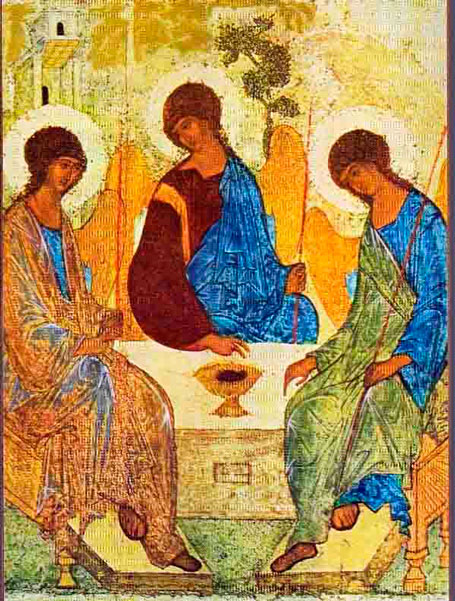This was written by Bill Gaultiere published by Trinity Episcopal

“Andrei Rublev painted “The Hospitality of Abraham in 1411” for the abbot of the Trinity Monastery in Russia. Rublev portrayed what has become the quintessential icon of the Holy Trinity by depicting the three mysterious strangers who visited Abraham (Genesis 18:1-15).
“In the Genesis account the Lord visits Abraham in the form of three men who are apparently angels representing God. Abraham bows low to the ground before his three visitors and they speak to Abraham in union and are alternatively referred to by the Genesis writer as “they” or “the Lord.” Abraham offers them the hospitality of foot washing, rest under a shade tree, and a meal and they offered him the announcement that God was going to give he and his wife Sarah a son, though Sarah was far past the age of childbearing.
“Rublev was the first to paint only the three angelic figures and to make them of equal size. Rublev depicts the three as One Lord. Each holds a rod in his left hand, symbolizing their equality. Each wears a cloak of blue, the color of divinity. And the face of each is exactly the same, depicting their oneness.
“The Father is like the figure on the left. His divinely blue tunic is cloaked in a color that is light and almost transparent because he is the hidden Creator. With his right he blesses the Son – he is pleased with the sacrifice he will make. His head is the only one that is lifted high and yet his gaze is turned to the other two figures.
“The Son is portrayed in the middle figure. He wears both the blue of divinity and reddish purple of royal priesthood. He is the King who descends to serve as priest to the people he created and to become part of them. With his hand he blesses the cup he is to drink, accepting his readiness to sacrifice himself for humanity. His head is bowed in submission to the Father on the left.
“The Spirit is indicated in the figure on the right. Over his divinely blue tunic he wears a cloak of green, symbolizing life and regeneration. His hand is resting on the table next to the cup, suggesting that he will be with the Son as he carries out his mission. His head is inclined toward the Father and the Son. His gaze is toward the open space at the table.
“Did you notice the beautiful circular movement in the icon of Father, Son, and Spirit? The Son and the Spirit incline their heads toward the Father and he directs his gaze back at them. The Father blesses the Son, the Son accepts the cup of sacrifice, the Spirit comforts the Son in his mission, and the Father shows he is pleased with the Son. Love is initiated by the Father, embodied by the Son, and accomplished through the Spirit.”
From Henro Nouwen, Dutch priest (psychology professor, writer, theologian) writing more than 500 years after this painting, “The more we look at this holy image with the eyes of faith, the more we come to realize that it is painted not as a lovely decoration for a convent church, nor as a helpful explanation of a difficult doctrine, but as a holy place to enter and stay within.”
